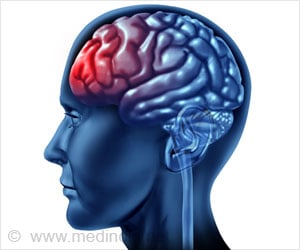Trauma may wake up sleeping brain viruses, paving the way for Alzheimer's. Could antiviral therapy after concussions be the key to prevention?
- Concussions may reactivate dormant brain viruses like HSV-1, causing inflammation and Alzheimer’s-like damage over time
- Lab models show repetitive brain injuries increase neurodegeneration risk, making antiviral treatments potential preventatives
- Beyond athletes, traumatic brain injury affects 69 million people globally, posing a significant health and economic challenge
Over 80% of people carry dormant HSV-1 in their brains. A jolt like a concussion could "wake it up," leading to neurodegeneration and Alzheimer's-like damage. #brainhealth #alzheimers #medindia’
Trauma Might Wake Up Dormant Viruses in Your Brain
Researchers at Tufts University and Oxford University have now discovered mechanisms that may connect the dots between trauma events and disease emergence, pointing to latent viruses lurking in most of our brains that may be activated by the jolt, causing inflammation and accumulating damage over months and years.The findings support the use of antiviral medicines as potential early preventative therapy following a brain injury. The findings have been reported in a research called Science Signaling (1✔ ✔Trusted Source
Study shows head trauma may activate latent viruses, leading to neurodegeneration
Go to source).
Your Gut Microbiome Isn’t the Only Place Viruses Hide
The microbiome- which contains hundreds of bacterial species that live in human bodies- helps with digestion, immune system development, and protection against hazardous pathogens. However, the microbiome also includes dozens of viruses that can swarm within our bodies at any time. Some of these are potentially hazardous, yet they remain dormant within our cells. Herpes simplex virus 1 (HSV-1), prevalent in more than 80% of individuals, and varicella-zoster virus, found in 95% of people, have been shown to enter the brain and sleep within our neurons and glial cells.Dana Cairns, a research associate in Tufts University's Department of Biomedical Engineering and the study's lead author, discovered evidence in previous studies that activating HSV-1 from its dormant state causes the signature symptoms of Alzheimer's disease in lab models of brain tissue- amyloid plaques, neuronal loss, inflammations, and diminished neural network functionality.
"In that study, another virus- varicella- created the inflammatory conditions that activated HSV-1," Cairns recalled. "We considered what would happen if we subjected the brain tissue model to a physical disruption similar to a concussion. Will HSV-1 awaken and begin the process of neurodegeneration?"
Concussions May Trigger Dormant Viruses to Start Alzheimer’s Processes
The relationship between HSV-1 and Alzheimer's disease was first proposed by co-author Ruth Itzhaki, a Visiting Professorial Fellow at Oxford University, who discovered the virus in a high proportion of aged brains more than 30 years ago. Her further research revealed that the virus can be triggered in the brain from a latent condition by stress or immunosuppression, resulting in neuronal damage. In the new work, the researchers developed a lab model that reconstructs the brain's environment to better understand how concussions can trigger the early phases of viral reactivation and neurodegeneration.The brain tissue model is constructed of a 6mm diameter donut-shaped sponge-like substance made of silk protein and collagen that is suffused with neural stem cells. These cells are then coaxed into adult neurons, sprouting axons and dendritic extensions and establishing a network. Glial cells develop from stem cells to replicate the brain environment and nurture neurons. Neurons communicate with one another via their extensions, just as they would in a brain. And, like brain cells, they can carry dormant HSV-1 viral DNA.
After putting the brain-like tissue in a cylinder and delivering it a quick jolt atop a piston to simulate a concussion, Cairns examined the tissue under the microscope over time. Some tissue models had HSV-1-infected neurons, while others were devoid of the virus. After the controlled blows, she noticed that the virus had reactivated in the infected cells, followed by the signature markers of Alzheimer's disease, such as amyloid plaques, p-tau (a protein that causes fiber-like "tangles" in the brain), inflammation, dying neurons, and gliosis, which is the proliferation of glial cells.
More piston impacts on the tissue models that mimicked repetitive head traumas resulted in the same, more severe effects. Meanwhile, cells that did not have HSV-1 showed some gliosis but no other Alzheimer's disease indicators.
Could Concussions Increase Alzheimer’s Risk?
The findings strongly suggested that sportsmen who have suffered concussions may be reactivating latent infections in the brain, which can contribute to Alzheimer's. Epidemiological studies have revealed that multiple hits to the head can increase the likelihood of developing a neurodegenerative disorder months or years later.This raises the question of whether antiviral medications or anti-inflammatory therapies could be used as early preventive therapy after head trauma to halt HSV-1 activation and reduce the likelihood of Alzheimer's disease," Cairns stated.
The problem extends far beyond the concerns of athletes. Traumatic brain injury is one of the leading causes of disability and mortality in adults, impacting around 69 million individuals globally each year and costing an estimated $400 billion yearly.
"The brain tissue model takes us to another level in investigating these connections between injury, infection, and Alzheimer's disease," said Tufts' Stern Family Endowed Professor of Engineering, David Kaplan. "We can recreate normal tissue settings similar to those seen inside the brain, track viruses, plaques, proteins, genetic activity, inflammation, and even evaluate the level of transmission between neurons. There is a lot of epidemiological research linking environmental factors to the development of Alzheimer's. The tissue model will enable us put that information into a molecular context and provide a starting point for testing new medications."
Reference:
- Study shows head trauma may activate latent viruses, leading to neurodegeneration - (https://www.eurekalert.org/news-releases/1069583)
Source-Medindia
















